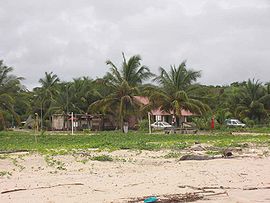
The Aluku are a Bushinengue ethnic group living mainly on the riverbank in Maripasoula in southwest French Guiana. The group are sometimes called Boni, referring to the 18th-century leader, Bokilifu Boni.
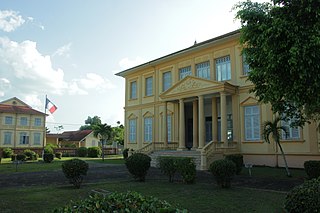
Saint-Laurent-du-Maroni is a commune of French Guiana, an overseas region and department of France located in South America. Saint-Laurent-du-Maroni is one of the three sub-prefectures of French Guiana and the seat of the Arrondissement of Saint-Laurent-du-Maroni. It is the second most populous city of French Guiana, with 50,250 inhabitants at the January 2021 census.

Saint-Georges is a commune of French Guiana, an overseas region and department of France located in South America. It lies on the Oyapock River, opposite the Brazilian town of Oiapoque. The town contains a town hall, a French Foreign Legion detachment, and some hotels. Saint-Georges has been one of the three sub-prefectures of French Guiana and the seat of the Arrondissement of Saint-Georges since October 2022.

Régina is a commune of French Guiana, an overseas region and department of France located in South America. With a land area of 12,130 km2 (4,680 sq mi), it is the second-largest commune of France. The town is named after the first merchant who settled in the area.

Iracoubo is a commune on the coast of French Guiana, an overseas region and department of France, located in South America.

Sinnamary is a town and commune on the coast of French Guiana, between Kourou and Iracoubo. Sinnamary was the second French settlement founded in French Guiana: the town was founded in 1664.
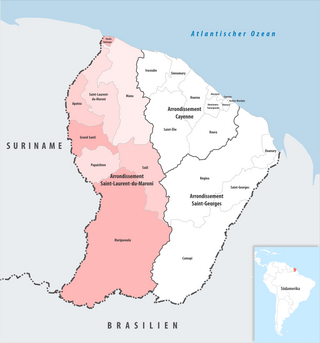
The arrondissement of Saint-Laurent-du-Maroni is an arrondissement of France in French Guiana department in French Guiana region. It has eight communes. Its population is 97,568 (2021), and its area is 40,945 km2 (15,809 sq mi).

Remire-Montjoly is a commune of French Guiana, an overseas region and department of France located on the northeast coast of South America.

The Kalina, also known as the Caribs or mainland Caribs and by several other names, are an Indigenous people native to the northern coastal areas of South America. Today, the Kalina live largely in villages on the rivers and coasts of Venezuela, Guyana, Suriname, French Guiana, and Brazil. They speak a Cariban language known as Carib. They may be related to the Island Caribs of the Caribbean, though their languages are unrelated.

Mana is a commune and town in French Guiana. It was founded on 16 August 1828 by Sister Anne-Marie Javouhey. It borders the river Mana, from where it gets its name; and is nearby the river Maroni. Mana is the primary producer of rice in French Guiana, which it exports to Suriname.

Maripasoula, previously named Upper Maroni, is a commune of French Guiana, an overseas region and department of France located in South America. With a land area of 18,360 km2 (7,090 sq mi), Maripasoula is the largest commune of France. The commune is slightly larger than the country of Kuwait or the U.S. state of New Jersey.
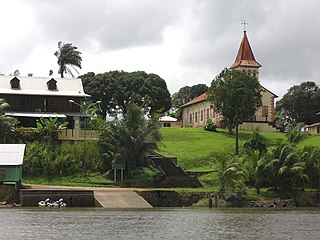
Roura is a commune of French Guiana, an overseas region and department of France located in South America. The city of Roura is bordered by Matoury and Montsinéry-Tonnegrande in the North, Kourou and Saint-Elie in the North West and West, and finally by Régina in the South and East.

Papaichton is a commune in the overseas region and department of French Guiana. The village lies on the shores of the Lawa River. Papaichton is served by the Maripasoula Airport.

Articles related to the French overseas department of Guiana(Région Guyane) include:

French Guiana is an overseas department and region of France located on the northern coast of South America in the Guianas and the West Indies. Bordered by Suriname to the west and Brazil to the east and south, French Guiana covers a total area of 84,000 km2 (32,000 sq mi) and a land area of 83,534 km2 (32,253 sq mi).As of January 2024, it is home to approximately 295,385 people.
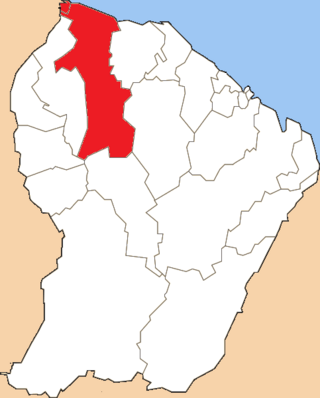
The canton of Mana is one of the former cantons of the Guyane department in French Guiana. It was located in the arrondissement of Saint-Laurent-du-Maroni, and consisted of two communes. Its administrative seat was located in Mana. Its population was 10,661 in 2012.

The Communauté de communes de l'Ouest guyanais (CCOG) is a communauté de communes, an intercommunal structure in the French département d'outre-mer of French Guiana. It was created in 1995, and its seat is Mana. Its area is 40,945 km2, and its population was 94,677 in 2018.

The Amana Nature Reserve is a nature reserve in French Guiana, France. It has been protected because it is one of the world's largest leatherback sea turtle nesting sites. It is part of the communes of Awala-Yalimapo and Mana.
Sainte-Rose-de-Lima is a village of Lokono Amerindians in the commune of Matoury in French Guiana. The village is located on the RN2 near Cayenne – Félix Eboué Airport. It is the largest settlement of Lokono in French Guiana.
